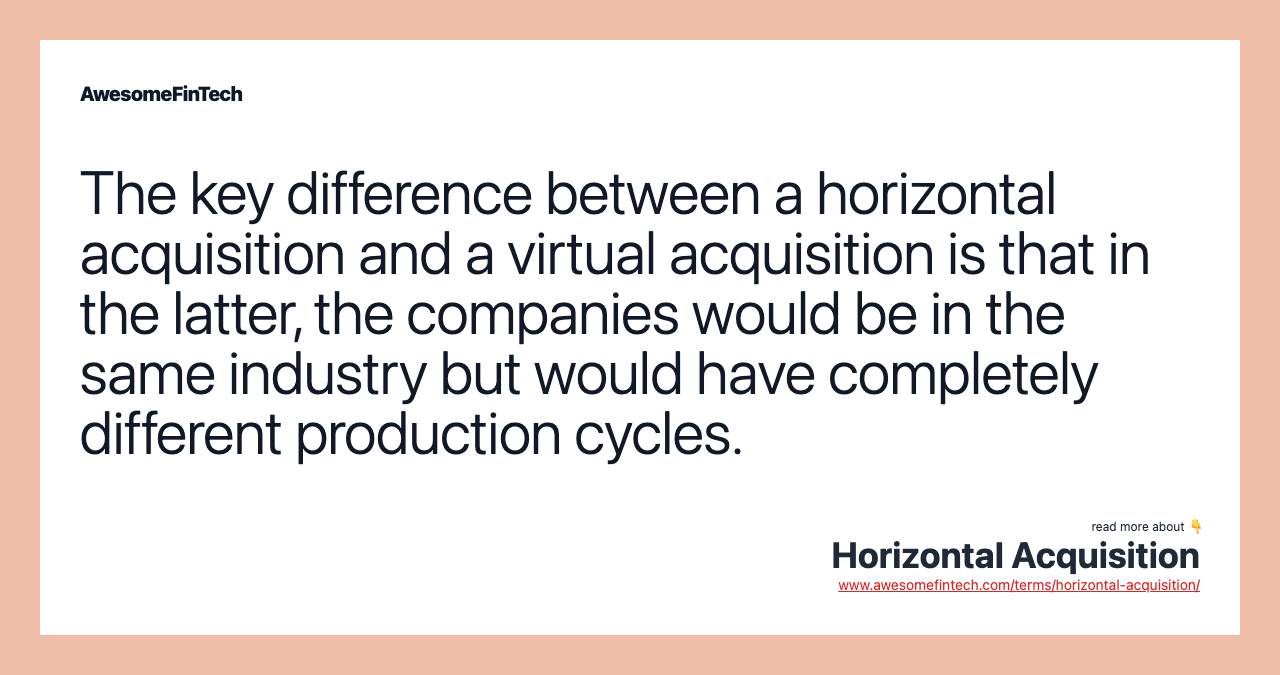Horizontal Acquisition
A horizontal acquisition is when one company acquires another company in the same industry and works at the same production stage. An example of a horizontal acquisition would be a candy company that purchasing another candy company with different products but a similar production schedule. During a horizontal acquisition, a company can expand its production of products, but it doesn't mean a pivot for the company. A horizontal acquisition is when one company acquires another company in the same industry and works at the same production stage. In a vertical acquisition, the two companies would be in the same industry, like food production or energy, but at different stages of the production cycle.

What Is a Horizontal Acquisition?
A horizontal acquisition is when one company acquires another company in the same industry and works at the same production stage. The new combined entity may be in a better competitive position due to increased market share or scalability than the standalone companies combined to form it.





Understanding Horizontal Acquisitions
The companies involved in a horizontal acquisition generally produce the same goods or services and produce them at the same point in the production cycle. This is so the new entity can experience more production capacity and take advantage of an increased market share. If the companies were at different stages of the production cycle, the equipment may not overlap and be as valuable to the acquiring entity.
And integrating two like companies in a horizontal acquisition can be challenging if the company cultures are vastly different. There are different types of acquisitions, some of which focus on obtaining equipment or control of operations at another point in the production cycle.
After a horizontal acquisition, a company will gain access to a wider customer base.
In a vertical acquisition, the two companies would be in the same industry, like food production or energy, but at different stages of the production cycle. This allows the acquiring company to obtain equipment that is either further upstream from the end client (backward vertical integration) or further downstream towards the end client (forward vertical integration). This gives the acquiring company more control over the production.
Horizontal integrations allow the purchasing company to reduce competition by acquiring it, diversify product offerings, creating new products, grow in size, and tap into new markets.
Example of a Horizontal Acquisition
For example, an energy producer purchases a rival that also produces energy. This is a horizontal acquisition because it is within the same industry and production schedule.
Next, the same energy producer purchases a company that manages and maintains city power grids. This is an example of a forward vertical integration because the energy producer has purchased a company responsible for bringing its product closer to the end consumer.
Related terms:
Accounting
Accounting is the process of recording, summarizing, analyzing, and reporting financial transactions of a business to oversight agencies, regulators, and the IRS. read more
Acquirer
An acquirer is a company that acquires rights to another company or business relationship through a deal. read more
Congeneric Merger
A congeneric merger is where the acquiring company and the target company do not offer the same products but are in a related industry or market. read more
Conglomeration
Conglomeration describes the process by which a conglomerate is created, as when a parent company begins to acquire subsidiaries. read more
Goodwill : How Is It Used in Investing?
Goodwill is an intangible asset when one company acquires another. It includes reputation, brand, intellectual property, and commercial secrets. read more
Horizontal Integration
Horizontal integration is the acquisition of a business that operates in the same industry. read more
Horizontal Merger
A horizontal merger is a merger or business consolidation that occurs between firms that operate in the same industry, usually as larger companies attempt to create more efficient economies of scale. read more
Market Share
Market share shows the size of a company in relation to its market and its competitors by comparing the company’s sales to total industry sales. read more
Mergers and Acquisitions (M&A)
Mergers and acquisitions (M&A) refers to the consolidation of companies or assets through various types of financial transactions. read more